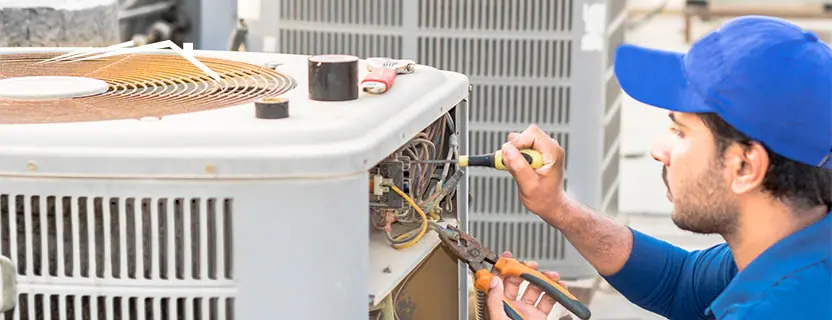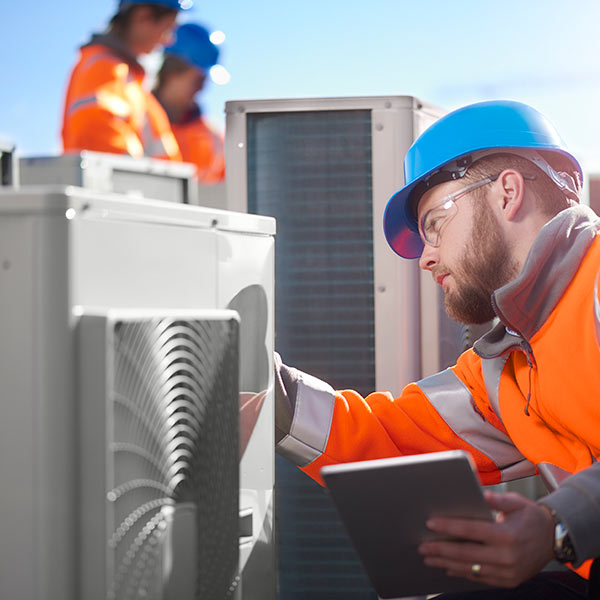The Homeowner’s Handbook to Installing ductless mini splits in Any Home Type
The Homeowner’s Handbook to Installing ductless mini splits in Any Home Type
Blog Article
Just How a Heat Pump and Heating System Collaborate to Enhance Your Home's Home heating Effectiveness
Comprehending just how a heatpump and heater work together is necessary for house owners seeking efficient home heating services. Each system has its strengths, offering a well balanced approach to home convenience. The heatpump stands out in modest temperature levels, while the heating system provides quick warmth during extreme cold. This harmony not just reduces power prices yet also improves the life-span of both devices. What elements influence this collaboration, and exactly how can home owners maximize their benefits?
Comprehending Warm Pumps: How They Function
Several individuals might be unknown with their internal functions, warm pumps play an essential duty in modern home heating systems. These gadgets run by moving warm from one location to one more, using the principles of thermodynamics. In chillier months, a heatpump removes warm from the outdoors air, ground, or water, and transfers it inside your home to warm up the space. On the other hand, throughout warmer months, it can turn around the procedure, serving as an air conditioning system by expelling warmth from inside to the outside.Heat pumps contain an evaporator, condenser, growth, and compressor valve. The refrigerant within the system takes in heat as it vaporizes at reduced temperatures and stress. The compressor after that boosts the pressure and temperature level of the refrigerant, permitting it to release warm as it condenses. This reliable procedure can greatly decrease power usage compared to conventional home heating methods, making heat pumps a lasting choice for climate control in homes.
The Function of Furnaces in Home Home Heating
Heating systems play a vital duty in home heating by supplying a dependable resource of warmth throughout the colder months. They operate by creating warm via burning or electric resistance, dispersing it throughout the home through ducts or glowing systems. The performance of a furnace is commonly gauged by its Yearly Fuel Usage Efficiency (AFUE) rating, which indicates exactly how effectively the device converts fuel into heat.Furnaces can utilize numerous power sources, including natural gas, electrical power, propane, or oil, permitting house owners to select the most ideal choice for their demands. Unlike heat pumps, which might battle in severe cold, heating systems preserve consistent performance, making sure that interior temperature levels continue to be comfortable no matter outdoor problems. Furthermore, modern furnaces usually come outfitted with innovative technology, such as smart thermostats and variable-speed blowers, enhancing their effectiveness and responsiveness. This convenience makes furnaces an important component in all-inclusive home heating techniques.

Benefits of Making Use Of Both Systems With Each Other
Combining the strengths of both furnaces and warmth pumps can result in a much more reliable and reliable home heating service. Utilizing both systems allows house owners to make the most of the warm pump's energy performance during milder temperatures while depending on the furnace for more severe cold problems. This dual method can substantially decrease energy expenses, as heatpump eat less electrical energy than traditional heating techniques when temperatures are moderate.Additionally, using both systems together can enhance convenience degrees in the home. Heatpump can provide constant, even home heating, while heating systems can quickly increase ambient temperature levels when needed. Furthermore, the combination of both systems can prolong the lifespan of devices by minimizing deterioration on each device, as they share the work. Eventually, homeowners can enjoy a well balanced, cost-effective home heating solution that readjusts effortlessly to varying weather condition conditions, making sure a warm and welcoming home throughout the winter season.
Just How Heat Pumps and Furnaces Enhance Each Other
When property owners incorporate warmth pumps and heating systems, they develop a complementary furnace that makes the most of effectiveness and convenience. Warm pumps operate by moving heat from the outside air or ground, making them very effective in moderate environments. They excel during milder temperatures, supplying cost-efficient heating. On the other hand, heating systems create warmth with burning or electrical resistance, delivering solid, prompt warmth during severe chilly conditions.The combination of these 2 systems permits vibrant modifications based upon temperature level changes. During warmer months or milder winter season days, the warm pump can take the lead, saving power and reducing costs. As temperature levels drop, the furnace can seamlessly involve, making sure consistent heat throughout the home. This harmony not just optimizes power use but also improves the life-span of both systems, as each device runs within its excellent performance variety. Together, they develop a balanced environment that adapts to varying environment needs.
Maximizing Effectiveness: Tips for Homeowners
Homeowners can boost their heating efficiency via a number of useful techniques. Establishing a normal upkeep timetable, integrating clever thermostat technology, and implementing reliable insulation and securing remedies are i loved this key actions. These procedures not just improve comfort but likewise minimize power prices.
Normal Maintenance Schedule
To guarantee optimal home heating performance, developing a normal upkeep timetable is important for any kind of home. House owners should prioritize regular inspections of both heatpump and heaters to ascertain peak performance. This consists of changing air filters each to three months, as clogged filters can greatly reduce effectiveness. Furthermore, organizing expert maintenance a minimum of when a year enables professionals to determine and deal with possible issues before they escalate. House owners ought to additionally cleanse the heat pump's outdoor unit to avoid particles buildup that can impede air flow. By sticking to a routine maintenance schedule, property owners not just enhance their heater' performance but also extend their life expectancy, resulting in greater comfort and lowered power costs throughout the chillier months.
Smart Thermostat Integration
Incorporating a clever thermostat into a home heater can helpful hints greatly improve energy performance, specifically as it enables specific control over temperature level settings. These gadgets can discover the home owner's timetable and choices, instantly adjusting the temperature level to optimize convenience while lessening power use. For instance, they can lower home heating throughout times when the home is empty, decreasing unnecessary usage. Lots of smart thermostats additionally give real-time power usage information, making it possible for property owners to make educated decisions about their heating routines. Additionally, remote access using smartphone applications allows customers to adjust setups from anywhere, making certain the home is warm upon return. On the whole, smart thermostat assimilation not just improves convenience but considerably adds to energy cost savings and performance.
Insulation and Sealing Solutions
Smart thermostats play a vital role in energy performance, but their performance can be considerably boosted by proper insulation and securing services. House owners need to prioritize insulating attics, wall surfaces, and floorings to lessen warmth loss. Top notch insulation materials, such as spray foam or fiberglass, can considerably boost thermal resistance. Additionally, sealing gaps around air ducts, windows, and doors avoids chilly air infiltration and warmth retreat. Weatherstripping and caulking work techniques for resolving these leakages - heat pump service. Regular examinations for air leakages, in addition to the usage of blower door examinations, can aid determine issue areas. By buying insulation and like it sealing, home owners can enhance the performance of their furnace, eventually bring about minimized energy usage and reduced utility expenses
Typical Myths Regarding Heat Pumps and Furnaces
What misconceptions surround warm pumps and heating systems? Many people wrongly think that heatpump are inadequate in colder environments. In truth, modern-day heatpump are developed to run efficiently even in reduced temperature levels, supplying dependable home heating throughout winter months. One more common myth is that heaters are always extra efficient than heatpump. Nevertheless, this depends upon the certain energy resources and efficiency rankings of the systems concerned. Some might also assume that utilizing both systems concurrently is unneeded, yet in reality, this combination can enhance heating performance, specifically throughout severe weather. In addition, individuals frequently assume that heatpump call for continuous upkeep, when in reality, they have similar maintenance needs to standard furnace. By disproving these misconceptions, property owners can make more enlightened choices concerning their heating options, eventually leading to improved convenience and energy performance in their homes.
Maintenance Factors To Consider for Combined Equipments

Often Asked Concerns
Can Heat Pumps Work Successfully in Incredibly Cold Climates?
Warm pumps can have a hard time in very cold climates as a result of decreased efficiency and warmth extraction constraints. Advancements in modern technology have led to versions designed for better efficiency in such conditions, boosting their stability in extreme environments.
For How Long Do Warm Pumps and Furnaces Normally Last?
Heat pumps usually last 15 to 20 years, while heaters have a life expectancy of 15 to three decades. Regular upkeep can prolong their longevity, guaranteeing effective operation and decreasing the need for early substitutes.

What Is the Average Expense of Putting Up Both Solutions?
The average expense of setting up both a heatpump and a furnace usually varies in between $5,000 to $10,000 - ductless mini splits. Aspects affecting this price consist of system size, installation complexity, and local labor rates
Exist Tax Obligation Incentives for Utilizing Energy-Efficient Heating Equipments?
Numerous homeowners ask about tax rewards for energy-efficient furnace. Different federal and state programs commonly provide refunds or credit ratings, urging the adoption of sustainable innovations to reduce energy intake and promote environmental duty.
Just how Do I Pick the Right Size Heatpump and Heating System?
Selecting the ideal dimension warm pump and heater includes determining the home's square video, taking into consideration insulation high quality, and reviewing local climate. Consulting a specialist can guarantee perfect system efficiency and power performance based upon certain requirements. furnace replacement. Comprehending how a warm pump and heater work together is essential for house owners looking for effective home heating solutions. In colder months, a heat pump removes warmth from the outdoors air, ground, or water, and transfers it inside to warm the living space. When house owners incorporate heat pumps and furnaces, they create a complementary heating system that optimizes efficiency and convenience. Warmth pumps operate by moving warmth from the outdoors air or ground, making them extremely efficient in modest environments. Warmth pumps can have a hard time in very cool climates due to lowered efficiency and warmth extraction constraints
Report this page